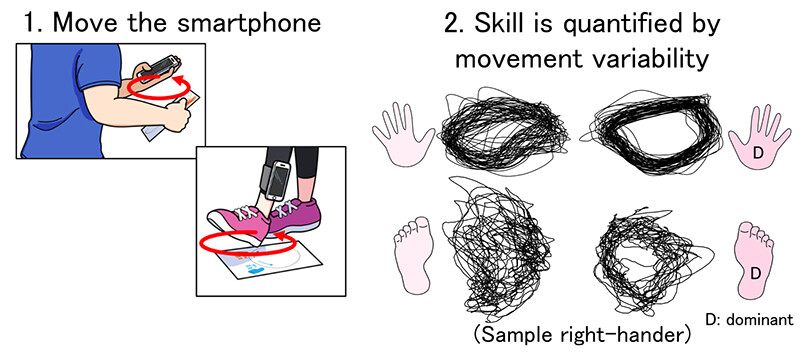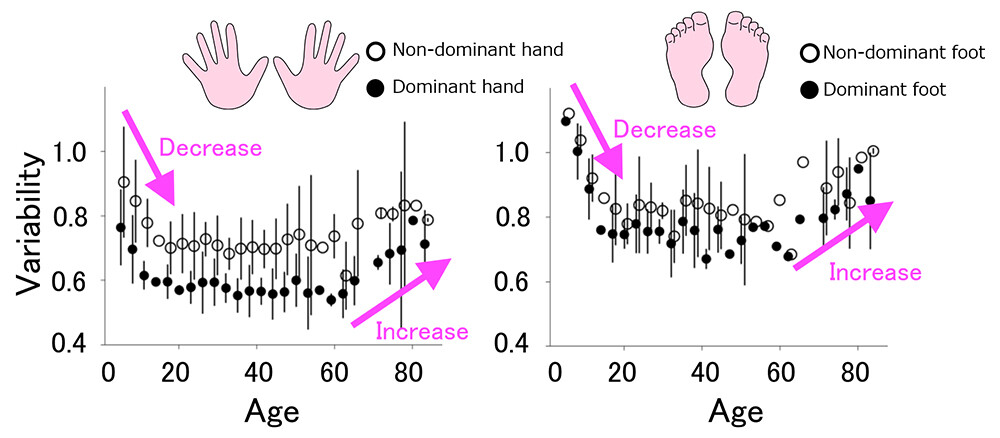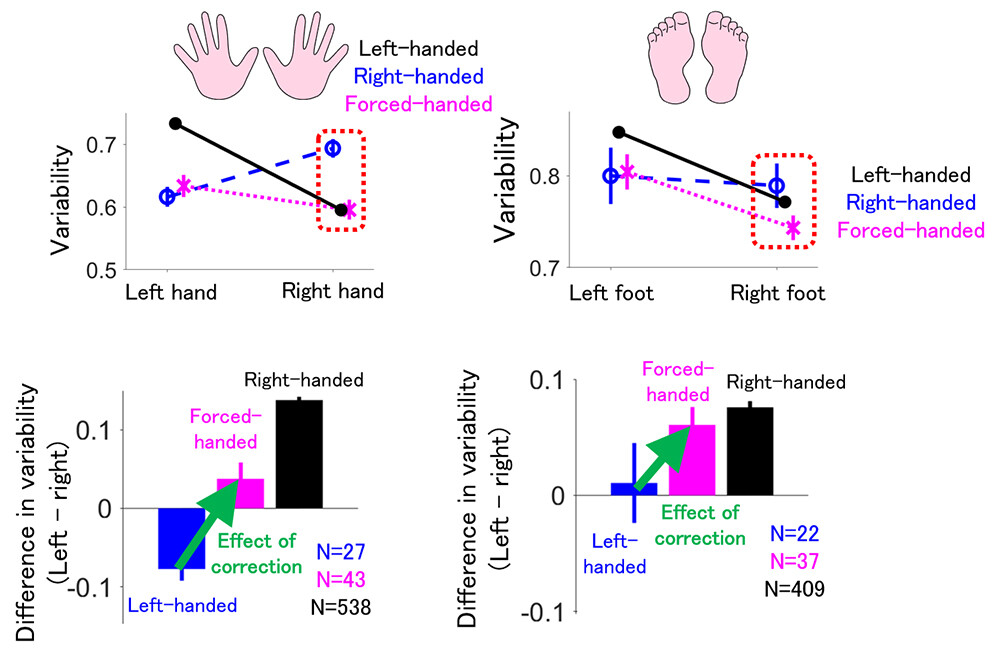Microsoft ends support for Internet Explorer on June 16, 2022.
We recommend using one of the browsers listed below.
- Microsoft Edge(Latest version)
- Mozilla Firefox(Latest version)
- Google Chrome(Latest version)
- Apple Safari(Latest version)
Please contact your browser provider for download and installation instructions.
June 17, 2024
NTT Corporation
NTT developed a method to quantify hand and foot skill by moving a smartphone
Visualizing the variation of motor skill with growth, aging, and training to contribute to improving performance
News Highlights:
- We will showcase a new method to easily visualize the skill1 of the hands and feet, which was previously difficult to quantify, by examining the cyclical motion of a smartphone for a short period of time.
- By using this method to evaluate the movement variability2 of children and the elderly, it became clear that skill changes with age, and it became possible to evaluate one's skill level relative to individuals of the same age. In addition, forced use of the right hand affected the relative skill of the left and right hands. Surprisingly, this forced correction affected the relative skill between the left and right feet as well.
- The development of this research is expected to contribute to the visualization of the recovery process through exercise rehabilitation in the medical and nursing fields, as well as to quantify the effects of training during sports activities.
Tokyo - June 17, 2024 - NTT Corporation (Headquarters: Chiyoda Ward, Tokyo; Representative Member of the Board and President: Akira Shimada; hereinafter "NTT") has developed a method to visualize the degree of skill1 by quantitatively evaluating the variability during short-term cyclical movements. This method makes it possible to measure the skill of hand and foot movements easily without using special equipment. The development of this technology to easily evaluate skill is expected to visualize the recovery process during physical rehabilitation and the effect of physical training during sports activities.
This result will be exhibited at the Open House 2024 of the NTT Communication Science Laboratories to be held from June 24.
 Figure 1 Visualizing Hand and Foot Skill On-the-spot
Figure 1 Visualizing Hand and Foot Skill On-the-spot
1. Background of the study
Through learning, humans move as they wish based on complex sensory information. However, unlike robots, even the most practiced movements are variable. This variability has long been a focus in the field of motor control.
To understand the mechanism of information processing in the brain that moves the hands and feet, it is necessary to investigate how movement variability changes with age and training. NTT has a history of conducting research to understand how the brain processes sensory information and uses it to control movements to build human-centered ICT. In this research, we have been investigating a method to more easily measure movement variability, which is deeply related to a person's ability to move as intended.
Conventionally, the "ability to move the hand as intended" has been evaluated by task completion rate, such as how many thin rods can be inserted into a hole or how many small blocks can be moved in a given time. However, these methods require special equipment, making it inconvenient to assess skill. Therefore, it was difficult to measure the skill of a large number of participants over a wide range of ages, and to readily investigate the effects of growth and aging, and to observe changes in skill resulting from training. Foot skill has been assessed by measuring the ability to balance on one foot, but this is not a suitable measure of foot skill itself because balance control involves whole-body control and sensory information processing not directly related to the foot.
2. Content of the research
In this research, we focused on movement variability during cyclical motion at relatively high speeds to easily and reliably measure whether the movement can be performed as intended. Simple repetitive movements can be used to assess variability even for short periods of time. In this study, we developed an algorithm to quantify the variability in acceleration trajectories when a person moved a smartphone for 15 seconds using their hand or foot (Figure 2).
 Figure 2 Visualization of the Movement Variability during Cyclical Movements of the Hands and Feet
Figure 2 Visualization of the Movement Variability during Cyclical Movements of the Hands and Feet
Figure 2 shows an example of acceleration trajectories for both the hands and feet of a right-handed person. When comparing the left and right trajectories, it appears that there is less variability in the trajectories on the right side than on the left side. By utilizing the developed algorithm, the amount of movement variability was quantified from the acceleration trajectory.
The graph (Figure 3), which quantifies the data obtained from a total of 608 subjects between the ages of 4 and 88, shows that the amount of variability on the dominant and non-dominant3 sides of both hands and feet decreases with growth, then stays constant, but it begins to regress. We also found that the amount of variability on the dominant side was smaller than that on the non-dominant side for both hands and feet.
 Figure 3 Variability of Hands and Feet Decreases with Growth and Increases in the Elderly
Figure 3 Variability of Hands and Feet Decreases with Growth and Increases in the Elderly
Next, to examine whether this difference in skill between the dominant and non-dominant hands and the variability between the right and left hands were affected by forced correction or usage of the right hand in early childhood, the variability was evaluated for right-handed, left-handed, and forced-handed individuals (Questionnaire survey: 538 right-handers, 27 left-handers, 43 forced-handers) (Figure 4). For right-handed people, the left hand had more variability, and for left-handed people, the right hand had more variability. Also, we observed that people who were forced to use their right hand had less variability in both their left and right hands. Training to use the right hand not only improved skill in the right hand but it did not cause the left hand's variability to increase, i.e., the left hand's skill did not decrease.
 Figure 4 Forced Use of the Right Hand Affects the Variability of the Hands and Feet and the Difference in Variability Between the Left and Right Sides.
Figure 4 Forced Use of the Right Hand Affects the Variability of the Hands and Feet and the Difference in Variability Between the Left and Right Sides.
We also analyzed the variability of the feet by dividing the group into left-handed, right-handed, and forced-handed individuals. On average, right-handed people had less variability in their right foot (meaning they were right-footed), whereas left-handed people had no difference in variability between their left and right feet. Surprisingly, forced-handed people had less variability in their right foot than in their left despite only being forced to use their right hand. Our results revealed that forced use of the right hand not only changed the difference in skill between the left and right hands, but it also affected the difference in skill between the right and left feet.
3. Outlook
In the future, we plan to increase the number of participants in the experiment to clarify differences in the degree of skill of the hands and feet depending on experience in certain sports. Since the improvement of skill can be easily visualized, we envisage the method being used for monitoring and evaluation of individual skill in diverse scenarios such as in gyms, club activities, rehabilitation facilities, and for medical care. We also aim to develop the method as a tool to explore the relationship between motor function and information processing in the brain.
1Skill: Skillful movements are determined by two factors, namely learning how to move correctly and how repeatable the motion is. The focus has been placed on correct movements but this depends on the task and can be redundant. Here, we developed a method to measure skill by focusing on the repeatability of the movement, which was quantified by calculating the variability of cyclical motion.
2Variability: The difference between the three-dimensional acceleration trajectories of two consecutive periods of periodic motion is expressed on a distance scale, and the average obtained for all periods is defined to be the variability.
3Dominant and non-dominant: The dominant hand is the hand that is used mainly in daily life, such as writing, or throwing a ball, as determined by the Edinburgh Handedness Inventory. The dominant foot is the one that kicks a ball or is the first to climb stairs, which was determined by the Lateral Preference inventory.
About NTT
NTT contributes to a sustainable society through the power of innovation. We are a leading global technology company providing services to consumers and businesses as a mobile operator, infrastructure, networks, applications, and consulting provider. Our offerings include digital business consulting, managed application services, workplace and cloud solutions, data center and edge computing, all supported by our deep global industry expertise. We are over $97B in revenue and 330,000 employees, with $3.6B in annual R&D investments. Our operations span across 80+ countries and regions, allowing us to serve clients in over 190 of them. We serve over 75% of Fortune Global 100 companies, thousands of other enterprise and government clients and millions of consumers.
Media contact
NTT Science and Core Technology Laboratory Group
Public Relations
nttrd-pr@ml.ntt.com
Information is current as of the date of issue of the individual press release.
Please be advised that information may be outdated after that point.
NTT STORY
WEB media that thinks about the future with NTT










